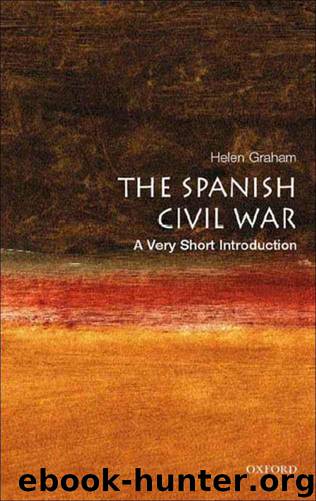The Spanish Civil War: A Very Short Introduction (Very Short Introductions) by Graham Helen

Author:Graham, Helen [Graham, Helen]
Language: eng
Format: mobi, epub
Publisher: Oxford University Press
Published: 2005-03-23T16:00:00+00:00
Chapter 5
The Republic besieged
A society struggling to progress is reduced by external aggression to levels of hardship and sheer survival that the aggressor then adduces as proof of the impossibility of social progress.
(Eduardo Galeano)
To fight on because there was no other choice, even if winning was not possible, then to salvage what we could – and at the very least our self respect…. Why go on resisting? Quite simply because we knew what capitulation would mean.
(Juan Negrín)
By the middle of 1937, the Republic faced an increasingly well-equipped enemy regularly and efficiently supplied with the best-quality military hardware direct from German and Italian factories. Non-Intervention did nothing to stop or even slow up this flow of war materiel. Often it was sent in ships chartered and paid for by Nazi Germany but which sailed under flags of convenience and were thus beyond the reach of Non-Intervention Committee controls. Given its relative proximity to Spain, Italy used its own merchant fleet, protected by the Italian air force or by its own warships, which no one, certainly not the Royal Navy, was prepared to challenge. This assured Franco of a rapid and virtually uninterrupted supply – the timeliness of deliveries often being a much more important factor than their scale. German and Italian supplies were also unloaded in Portuguese ports with the complicity of the authorities. Since the aid from Germany and Italy came direct from government, it also arrived with fully integrated technical support and logistical back-up. Up against this, Soviet-procured aid to the Republic could not compensate quantitatively or qualitatively. It could thus only ever offer the Republic scant survival.
Stalin was neither willing nor able to send precious material from Soviet factories in a quantity that could have allowed the Spanish Republic to compete on equal terms on the battlefield once Italy and German stepped up their support for Franco at the end of 1936. In 1937 Soviet industrial production was still in a turmoil of reorganization, made worse by the purges, and throughout the war in Spain real Soviet production levels remained anything up to 50% below the published ones. Given this situation, it is surprising that Stalin sent even as much domestically produced materiel to the Republic as he did. This was high quality – most crucially the planes and tanks – and, as we have seen, it was vital to Republican survival, especially at the start. But much of the ‘Soviet aid’ that kept the Republic ticking over did not originate in Soviet factories at all, rather it was obtained from elsewhere by the Soviet Union acting as a broker.
The Republic needed the Soviet Union’s services because Non-Intervention stopped it from purchasing war materiel on its own behalf on the open market – even though this embargo, which prevented a democratically elected government from buying arms to defend itself, probably contravened international law. As an extension of the partisan logic of Non-Intervention, nor were there, so the Republican government discovered, any safe channels in the Western banking sector through which it could mobilize its financial resources for war.
Download
The Spanish Civil War: A Very Short Introduction (Very Short Introductions) by Graham Helen.epub
This site does not store any files on its server. We only index and link to content provided by other sites. Please contact the content providers to delete copyright contents if any and email us, we'll remove relevant links or contents immediately.
| Africa | Americas |
| Arctic & Antarctica | Asia |
| Australia & Oceania | Europe |
| Middle East | Russia |
| United States | World |
| Ancient Civilizations | Military |
| Historical Study & Educational Resources |
The Radium Girls by Kate Moore(10914)
The Templars by Dan Jones(4192)
100 Deadly Skills by Clint Emerson(4084)
Rise and Kill First by Ronen Bergman(4016)
The Doomsday Machine by Daniel Ellsberg(3736)
The Rape of Nanking by Iris Chang(3522)
Killing England by Bill O'Reilly(3459)
Hitler in Los Angeles by Steven J. Ross(3443)
Stalin by Stephen Kotkin(3089)
12 Strong by Doug Stanton(3059)
Hitler's Monsters by Eric Kurlander(2736)
Darkest Hour by Anthony McCarten(2650)
Blood and Sand by Alex Von Tunzelmann(2611)
The Art of War Visualized by Jessica Hagy(2416)
Hitler's Flying Saucers: A Guide to German Flying Discs of the Second World War by Stevens Henry(2298)
The Code Book by Simon Singh(2215)
The Second World Wars by Victor Davis Hanson(2136)
Babylon's Ark by Lawrence Anthony(2073)
Tobruk by Peter Fitzsimons(2064)
